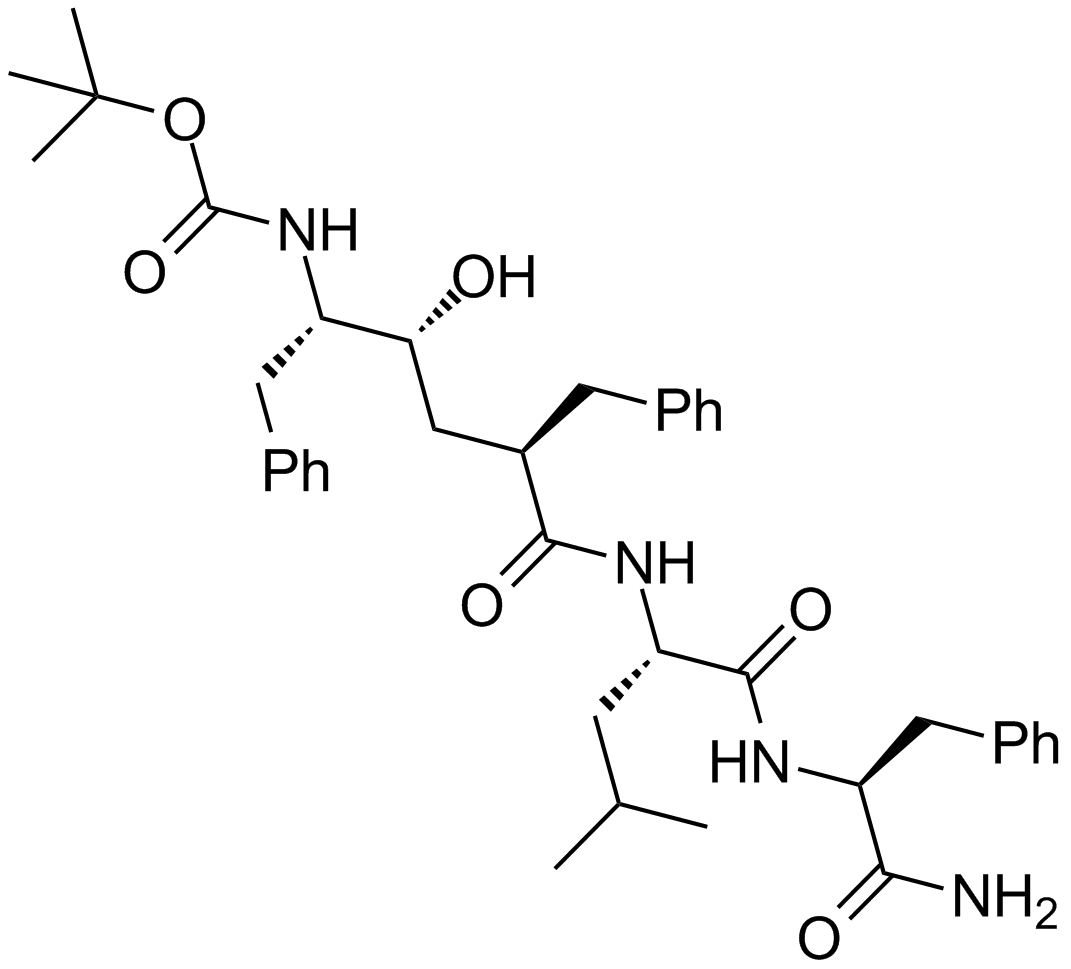L-685,458 (Synonyms: γ-Secretase Inhibitor X) |
| Catalog No.GC15364 |
A γ-secretase inhibitor
Products are for research use only. Not for human use. We do not sell to patients.

Cas No.: 292632-98-5
Sample solution is provided at 25 µL, 10mM.
L-685,458 is a selective and Potent inhibitor of γ-secretase with IC50 value of 17 nM[1].
γ-Secretase is one of intramenbrane-cleaving aspartyl protease which cleaves many type-I membrane proteins and many of them have important biological functions. γ-Secretase is a multi-subunit protease and it contains presenilin, nicastrin, APH-1(Anterior Pharynx- defective 1) and PEN-2. Presenilin contains Asp258 and Asp385 embedded in the sixth and seventh transmembrane domain and forms the active site. The feature of being a membrane integrated protease complex makes it difficult to be purified as well as studying its mechanism. γ-secretase is responsible for the generation Aβfrom the amyloid precusor protein. γ-Secretase has been considered as an important drug target for Alzheimer's disease. γ-Secertase also is responsible for Notch processing which is related to cancer such as leukemia.
L-685,458 is a transition state analogue inhibitor.
It is a pan-inhibitor of γ-secretase which decrease the products of Aβ(42) and Aβ(40) peptides. It displays a selectivity of 50-fold or greater inhibition than a range of aspartyl, serine, and cysteine protease in vitro membrane assay. L-685,458 reduced the product both total Aβand Aβ42 in human primary neuronal cells with IC50 value of 115 nM for Aβand Aβ42 for 200 nM[2]. L-685,458 also inhibitedγ-secretase activity by characterizing the production of total secreted Aβby ELISA with IC50 value of about 5 nM in HEK 293 cells overexpressing human APP751.
L-685,458 reduced the cortical total Aβwith a 50% reduction occurring at 100 mg/kg in a dose-dependent manner in PDAPP, and similar reductions in cortical Aβ42 were observed. L-685,458 decreased brain levels of Aβwhen given orally to Tg2576 mice that are transgenic for human APPV717F mutation. [3] L-685,458 also inhibit the Notch signaling, then affects embryonic development in zebrafish embryos[4].
References:
1.Shearman MS, Beher D, Clarke EE, Lewis HD, Harrison T, Hunt P, Nadin A, Smith AL, Stevenson G, Castro JL: L-685,458, an aspartyl protease transition state mimic, is a potent inhibitor of amyloid beta-protein precursor gamma-secretase activity. Biochemistry 2000, 39(30):8698-8704.
2.Dovey HF, John V, Anderson JP, Chen LZ, de Saint Andrieu P, Fang LY, Freedman SB, Folmer B, Goldbach E, Holsztynska EJ et al: Functional gamma-secretase inhibitors reduce beta-amyloid peptide levels in brain. J Neurochem 2001, 76(1):173-181.
3.Lanz TA, Himes CS, Pallante G, Adams L, Yamazaki S, Amore B, Merchant KM: The gamma-secretase inhibitor N-[N-(3,5-difluorophenacetyl)-L-alanyl]-S-phenylglycine t-butyl ester reduces A beta levels in vivo in plasma and cerebrospinal fluid in young (plaque-free) and aged (plaque-bearing) Tg2576 mice. J Pharmacol Exp Ther 2003, 305(3):864-871.
4.Geling A, Steiner H, Willem M, Bally-Cuif L, Haass C: A gamma-secretase inhibitor blocks Notch signaling in vivo and causes a severe neurogenic phenotype in zebrafish. EMBO Rep 2002, 3(7):688-694.
Average Rating: 5 (Based on Reviews and 30 reference(s) in Google Scholar.)
GLPBIO products are for RESEARCH USE ONLY. Please make sure your review or question is research based.
Required fields are marked with *




















